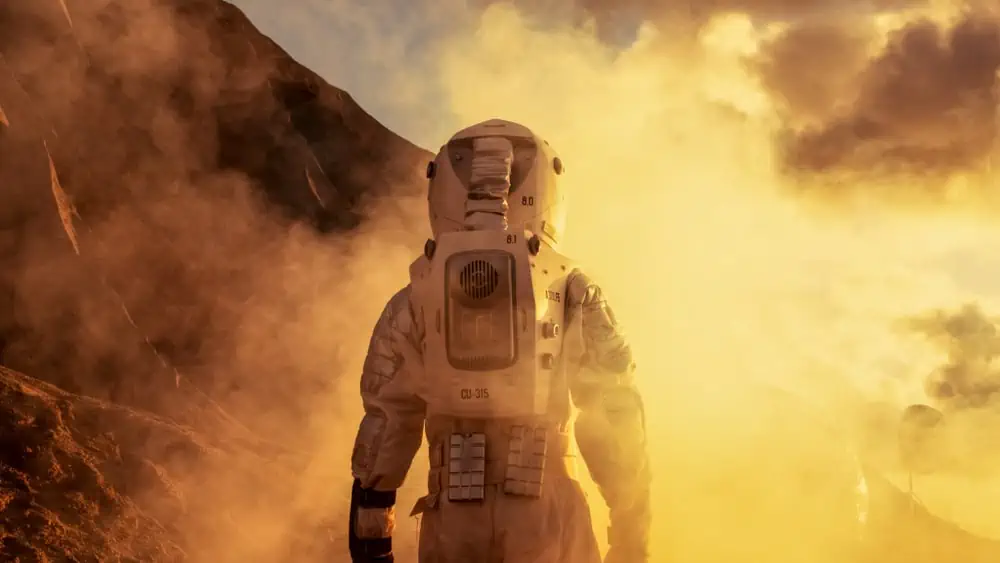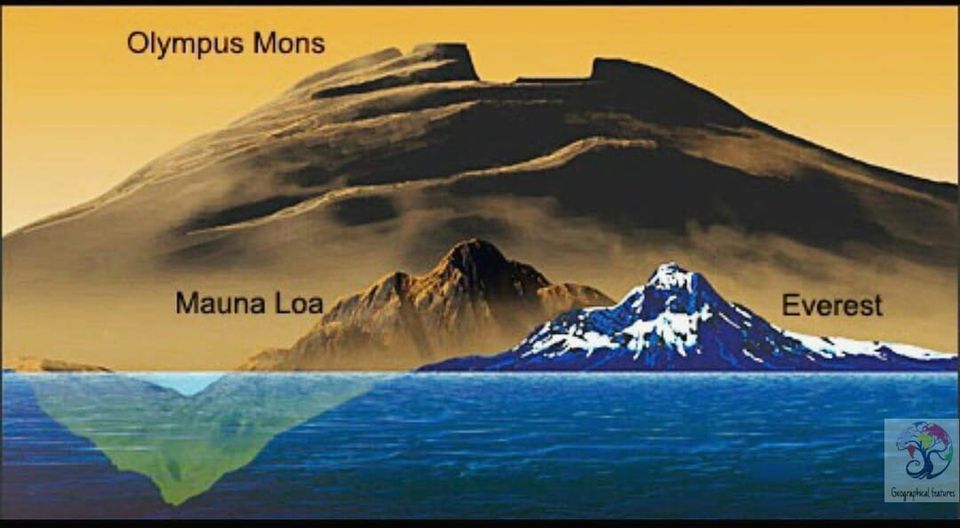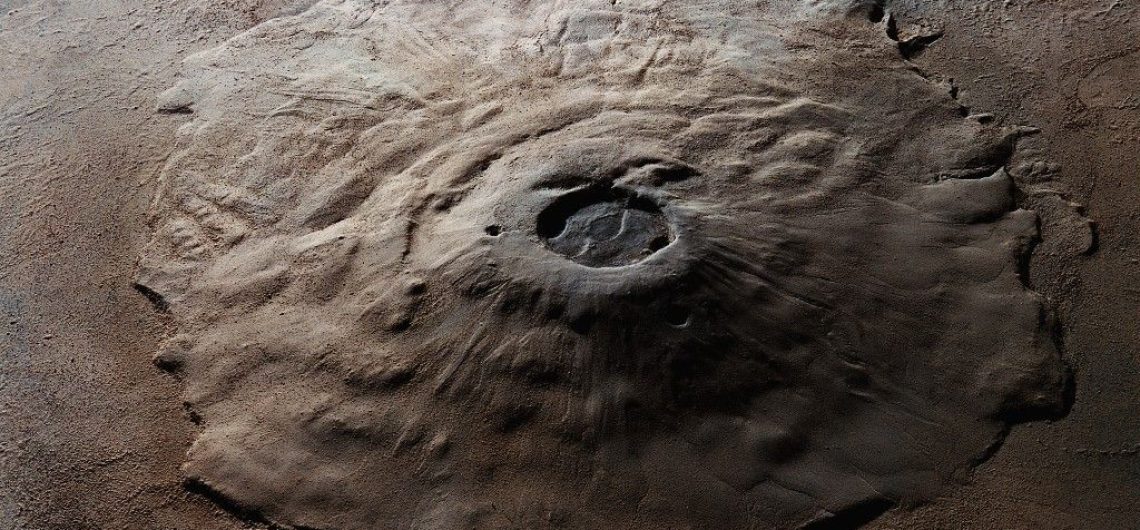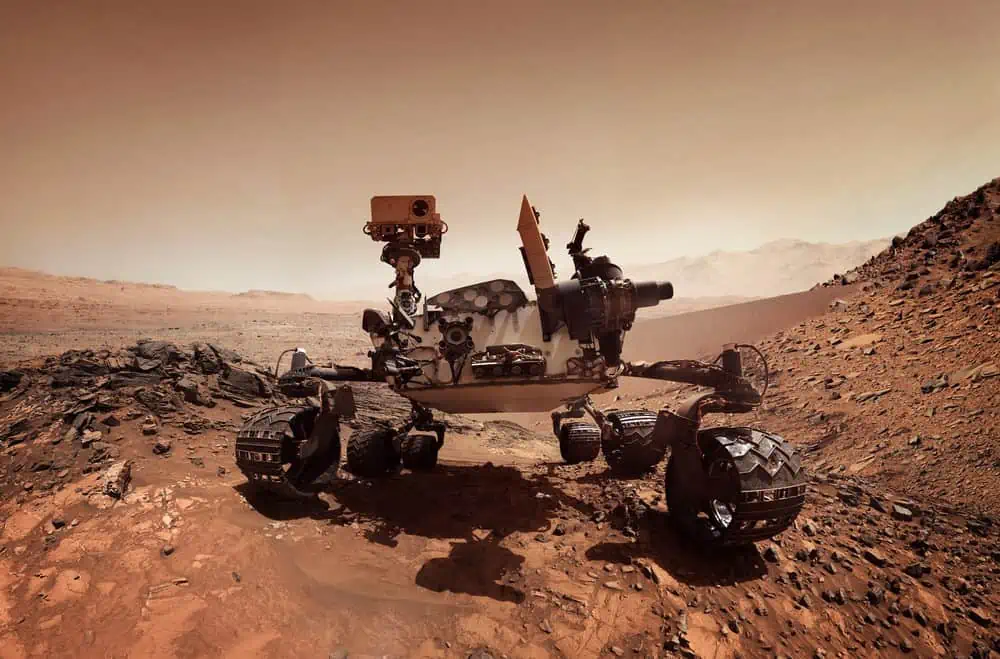On Mars, Mount Olympus, or Olympus Mons, as it is known in Latin is the solar system’s largest known volcano. It is a shield volcano, rather than violently spewing molten material. shield volcanoes are created by lava slowly flowing down the sights. The massive shield volcano is almost practically made up of basalt lava flows in towers at about 16 miles 25 kilometers above Mars’s surface, and has a diameter of 374 Miles 600 kilometers, making it roughly the size of Arizona. It wasn’t just about fit within the boundaries of France. It is so enormous that it could be recognized as a separate feature on telescopes as early as the 19 century. But it wasn’t until 1971 When NASA’s Mariner nine spacecraft arrived in orbit around Mars, that the nature of Mount Olympus was established not only as an outstanding mountain, but also as a volcano.
This volcano, which is roughly three times the height of Mount Everest, the highest point on Earth must have had a lot of activity and eruptions to grow to the size it is now. Because Olympus Mons is so large, the lava must have been quite runny, resulting in the smooth slopes that are seen. However, scientists don’t believe the volcano has erupted recently. They believe it last erupted about 4 billion years ago. And because of this, they concluded that it is a dormant volcano, one that is addressed because there isn’t much love or movement visible. After reviewing many photographs and scientific data obtained by satellites and rovers on Mars, they came to this conclusion. Also, they examined the rock in great detail and calculated the ages of the rocks visible on the surface. The rocks on the surface are cold. Since they have had plenty of time to cool down from the last time they erupted from the volcano. The average temperature of Mars today is minus 63 degrees Celsius, which is quite low. Temperatures must be extremely high for a volcano to erupt and melt rocks into lava. So Olympus Mons would have been far hotter billions of years ago.
When lava erupts from volcanoes on Earth, it can reach temperatures of 700 degrees Celsius to 1200 degrees Celsius. Volcanoes in Hawaii are more or less similar to Olympus Mons, in that they have very wide faces and very gentle slopes. Although volcanoes in Hawaii are much smaller, they are very similar. When lava gets hotter, it becomes runnier. And we know that the lava on Olympus Mons was ready because of the lengthy slopes observed, so the lava must have been extremely hot for it to be running. And if it was similar to the volcanoes in Hawaii, the lava would have been around 1200 degrees Celsius. If the lava had been any colder, it would not have been able to flow down the sides of the volcano, resulting in extremely steep slopes as it accumulated up near the top of the volcano. This would result in the formation of a different type of volcano, known as the Strato volcano. These types of volcanoes exist here on Earth, such as Mount St. Helens in the United States. Why would such a massive volcano erupt on Mars, but not on Earth? Scientists think that the Red Planet’s lower surface gravity, combined with faster eruption rates allowed the lava to pile up higher.
The presence or absence of tectonic plates may also impact the different types of volcanoes that exist. On both planets, the lava hotspots under the crust remain in the same location. However, the movement of the crust on Earth hinders the continuous buildup of lava. For example, the Hawaiian Islands formed as a plate drifted over a hotspot. Each eruption resulted in the formation of a little island in a different spot. However, plate movement on Mars is quite limited. Both the hotspot and the crust have remained stationary. When lava reaches the surface, it piles up in a single spot. Large volcanoes such as Olympus Mons form instead of a series of volcanic islands. Although we can’t visit Olympus Mons in person, we can learn a lot about the rocks and how they formed by using satellites and rovers as well as comparing them to similar volcanoes.
Here on Earth. The more we learn about Mars as a planet, the more we’ll be able to determine its past environment and how it evolved into what we observe today. If you liked this video, please consider subscribing and click the notification bell so you do not miss any upcoming videos.
Olympus Mons is a prominent feature in our solar system, specifically on the planet Mars. It is the largest volcano in our solar system and one of the most captivating geological formations known to astronomers and space enthusiasts.
Where is Olympus Mons located?
Olympus Mons is located on the planet Mars, specifically on the Tharsis bulge, which is a vast volcanic plateau near the Martian equator.
How tall is Olympus Mons?
Olympus Mons is a massive shield volcano, characterized by its broad, gently sloping sides and a relatively flat summit. It stands at an astounding height of approximately 13.6 miles (22 kilometres) and has a diameter of about 370 miles (600 kilometres). Its size is so immense that it dwarfs Earth’s tallest volcano, Mauna Kea, and even surpasses the largest mountains on our planet. Though the slopes of the mountain are gradual, its immense size is such that if standing at its base, the summit would stretch beyond the horizon.
Ho was Olympus Mons formed?
The formation of Olympus Mons can be attributed to the unique geological conditions on Mars. It is believed to have formed through thousands of volcanic eruptions over millions of years. The lava flows from these eruptions, consisting mainly of basaltic material, spread out across the surface, gradually building up the mountain to its current size. Due to Mars’ lower gravity compared to Earth, the lava flows were able to travel long distances before solidifying, resulting in the massive size of Olympus Mons.
Features and Characteristics:
Olympus Mons is known for its distinctive features and characteristics:
- It has a well-defined summit caldera, which is a large depression at the top of the volcano.
- The volcano’s slopes are relatively gentle, with an average gradient of only 5 degrees, making it easy to ascend and descend compared to steeper terrestrial mountains.
- The surface of Olympus Mons is relatively smooth, with fewer craters compared to other regions on Mars. This suggests that the volcano’s eruptions are relatively recent in geological terms.
Significance and Exploration:
Olympus Mons has captured the attention of scientists and space exploration enthusiasts alike. Its colossal size and unique geological features provide valuable insights into the geological processes that have shaped Mars. Various space missions, including orbiters and rovers, have been sent to Mars to study and capture images of Olympus Mons, further enhancing our understanding of the planet’s volcanic history.
How Was Olympus Mons Discovered?
Observations of Olympus Mons through telescopes began in the 19th century, but it wasn’t until the era of space exploration that its true magnificence was revealed. Mariner 9, the first spacecraft to orbit another planet, captured detailed images in 1971, unveiling a colossal mountain that outshone all others in the entire solar system. Embarking on a hut-to-hut hiking journey may not seem like the most obvious choice for a family vacation. Scaling up and down mountains, traversing a total elevation gain of 2,000 meters, sharing a dormitory with boisterous mountain lovers, and enduring the constant “Are we there yet?” from the kids may seem daunting. But believe it or not, hiking through the mountains can be an exciting adventure for all. At Bookatrekking.com, we firmly believe that the mountains have something to offer for everyone, even the youngest explorers and aspiring mountain climbers. With a well-planned itinerary, a sense of adventure, and guidance from our trekking experts and past clients, your entire family can embark on a memorable hut-to-hut journey. The exploration of Olympus Mons is an ongoing venture. Current and upcoming missions to Mars, including orbiters and rovers, are dedicated to studying this magnificent volcano and other geological features. The idea of human missions to Mars raises the exciting possibility of scientists standing on the slopes of Olympus Mons, conducting research up close. Just imagine – one day, humans might even reach the summit of the tallest mountain in the entire solar system!
 Why Olympus Mons is the highest mountain in the solar system
Why Olympus Mons is the highest mountain in the solar system
Mars lacks active plate tectonics like those found on Earth, where the movement of tectonic plates causes earthquakes, volcanic eruptions, and the formation of new land masses. Instead, Mars has what is known as “stagnant-lid” tectonics, where the planet’s crust is essentially immobile, with limited or no horizontal movement of its plates.
This geological difference has significant implications for the formation and persistence of volcanoes on Mars. Unlike on Earth, where volcanic activity can be concentrated along plate boundaries or hotspots that shift over time, volcanoes on Mars tend to remain stationary once they form. This lack of plate movement means that volcanic hotspots can build up massive, long-lasting volcanoes over millions of years without the threat of being overridden by shifting tectonic plates.
Olympus Mons, the largest volcano in the solar system, is a prime example of this phenomenon. Situated on the Martian Tharsis bulge, Olympus Mons is a shield volcano that rises nearly 22 kilometres (13.6 miles) above the surrounding plains, making it roughly two and a half times taller than Mount Everest. Its immense size and relatively smooth profile are characteristic of shield volcanoes formed by the eruption of low-viscosity lava over long periods.
The static nature of Mars’ crust allowed Olympus Mons to grow to such colossal proportions over billions of years without the disruptive forces of plate tectonics to impede its growth. As a result, Olympus Mons stands as a testament to the unique geology and volcanic history of Mars, showcasing the potential for extreme planetary-scale features in the absence of active plate tectonics.
Can you climb Olympus Mons?
Ascending Olympus Mons on Mars presents several challenges due to the thin atmosphere, extreme temperatures, massive dust storms, and lack of protection against radiation. Climbers would need to bring their own oxygen supply and protective gear to endure the harsh conditions. Despite the mountain’s gentle slope, reaching the summit would require hiking nearly 200 miles and gaining over 72,000 feet in elevation. The reduced gravity on Mars could make carrying weight easier but also impact balance and coordination. Additionally, the long-term health implications of extended periods in a lower gravity environment must be considered. The journey to Mars itself is also a significant feat, taking about seven months to cover a distance of 300 million miles.
 While Olympus Mons is the tallest volcano in the solar system, climbing it is currently not feasible for several reasons:
While Olympus Mons is the tallest volcano in the solar system, climbing it is currently not feasible for several reasons:
- Distance: Olympus Mons is located on Mars, which is millions of kilometres away from Earth. Travelling to Mars is currently not possible for humans, let alone attempting to climb a mountain on its surface.
- Atmosphere: Mars has a very thin atmosphere composed mostly of carbon dioxide, with a surface pressure of about 0.6% that of Earth’s. This means that humans cannot survive on the Martian surface without extensive life support systems, making climbing Olympus Mons physically impossible with current technology.
- Technical Challenges: Even if humans could somehow reach the surface of Mars, climbing Olympus Mons would present immense technical challenges due to its steep slopes, extreme height (approximately 21.9 kilometres or 13.6 miles), and the lack of specialized equipment and infrastructure.
How Old is Olympus Mons?
Olympus Mons, towering over the Martian landscape, started taking shape more than 3 billion years ago in the dynamic Hesperian Period of Mars. This era was marked by a flurry of volcanic eruptions and the gradual transformation of the planet’s terrain. Evidence suggests that the volcano has been sporadically erupting throughout much of Mars’ history. Remarkably, some of the most recent lava flows on the slopes of Olympus Mons are thought to be no more than 2 million years old, a mere moment in the vast timescale of geology. This finding indicates that Olympus Mons might have still been active quite recently, hinting at the ongoing volcanic potential of Mars.
Martian Volcanoes
Martian volcanoes are fascinating geological features found on the planet Mars. These volcanoes are distinct from those on Earth and offer unique insights into the planet’s history and geology. Mars is home to some of the largest volcanoes in the solar system, including Olympus Mons, which is the tallest volcano known in our solar system.
The Martian volcanoes are classified as shield volcanoes, similar to the volcanoes found in Hawaii. They have a broad, gently sloping shape characterized by a large caldera or summit crater. The shield-like appearance is due to the low viscosity of the lava flows on Mars, allowing them to spread out over large distances, creating a wide base.
One of the most notable Martian volcanoes is Olympus Mons, located in the Tharsis region of Mars. It stands at an impressive height of approximately 13.6 miles (22 kilometers) and has a diameter of about 370 miles (600 kilometers). Olympus Mons is estimated to be around 200 million years old and is thought to have formed through repeated volcanic eruptions over an extended period.
Other prominent Martian volcanoes include Arsia Mons, Pavonis Mons, and Ascraeus Mons, all part of the Tharsis volcanic region. These volcanoes, although smaller in size compared to Olympus Mons, still exhibit impressive features and contribute to the diverse volcanic landscape of Mars.
Studying Martian volcanoes provides valuable information about the planet’s past volcanic activity, its geological evolution, and the dynamics of volcanic processes on Mars. It also offers insights into the planet’s potential for past or present habitability and the possibility of underground water sources associated with volcanic activity.
Exploration missions like the Mars rovers and orbiters, along with data collected from remote sensing instruments, have significantly contributed to our understanding of Martian volcanoes. They have helped scientists map the distribution, composition, and history of these volcanic features, advancing our knowledge of Mars as a dynamic and geologically active planet.
As technology and exploration efforts continue to advance, future missions to Mars may further unravel the mysteries of Martian volcanoes and provide new insights into the planet’s geology, potential for life, and the broader understanding of our neighboring planet in the solar system.
Mount Olympus vs Mount Everest vs Mount Kilimanjaro

Olympus Mons, Mount Everest, and Kilimanjaro are all significant mountains on different celestial bodies. Here’s a comparison of these mountains:
Olympus Mons:
- Location: Olympus Mons is located on the planet Mars.
- Height: It is the tallest volcano in our solar system, with an elevation of approximately 13.6 miles (22 kilometers) from its base to its summit.
- Size: The diameter of Olympus Mons is about 370 miles (600 kilometers), making it one of the largest volcanoes in the solar system.
- Geological Features: Olympus Mons is a shield volcano, characterized by a broad, gently sloping shape and a large summit caldera. It formed through repeated volcanic eruptions over a long period of time.
Mount Everest:
- Location: Mount Everest is situated in the Himalayas on the border of Nepal and Tibet.
- Height: It is the highest mountain on Earth, with a peak at 29,032 feet (8,848 meters) above sea level.
- Size: Mount Everest has a relatively small footprint compared to Olympus Mons, with a base diameter of approximately 3.7 miles (6 kilometers).
- Geological Features: Mount Everest is a part of the Himalayan mountain range and is formed through the collision of tectonic plates. It consists of sedimentary and metamorphic rocks.
Kilimanjaro:
- Location: Kilimanjaro is located in Tanzania, East Africa.
- Height: It is the highest mountain in Africa, with its Uhuru Peak standing at 19,341 feet (5,895 meters) above sea level.
- Size: Kilimanjaro has a relatively large footprint, with a base diameter of approximately 25 miles (40 kilometers).
- Geological Features: Kilimanjaro is a dormant stratovolcano composed of layers of lava and volcanic ash. It is part of the East African Rift system.
Olympus Mons is significantly larger in size and elevation compared to Mount Everest and Kilimanjaro. While Olympus Mons is a shield volcano on Mars, Mount Everest is the tallest mountain on Earth located in the Himalayas, and Kilimanjaro is the highest mountain in Africa. Each mountain has its unique geological features and holds great significance in their respective contexts.
How many Mount Everests fit into Olympus Mons
The diameter of Olympus Mons is approximately 370 miles (600 kilometers), while Mount Everest has a relatively small base diameter of about 3.7 miles (6 kilometers). To calculate how many Mount Everests could fit into Olympus Mons, we can divide the diameter of Olympus Mons by the diameter of Mount Everest.
Approximately 100 Mount Everests could fit into the diameter of Olympus Mons. However, it’s important to note that this calculation is based on a simple comparison of diameters and does not take into account the varying shapes and terrain of the two mountains. Olympus Mons is a shield volcano with a broad, gently sloping shape, while Mount Everest is a pointed peak. Therefore, this comparison is purely for illustrative purposes and may not accurately represent the actual volume or mass of the mountains.
How many Kilimanjaros fit into Olympus Mons
The diameter of Olympus Mons is approximately 370 miles (600 kilometers), while the diameter of Mount Kilimanjaro is about 25 miles (40 kilometers). To calculate how many Kilimanjaros could fit into Olympus Mons, we can divide the diameter of Olympus Mons by the diameter of Mount Kilimanjaro.
Approximately 15 Kilimanjaros could fit into the diameter of Olympus Mons. However, it’s important to note that this calculation is based on a simple comparison of diameters and does not take into account the varying shapes and terrain of the two mountains. Olympus Mons is a shield volcano with a broad, gently sloping shape, while Mount Kilimanjaro is a stratovolcano with a tall, conical shape. Therefore, this comparison is purely for illustrative purposes and may not accurately represent the actual volume or mass of the mountains.
The key difference between Olympus Mons and Mount Everest lies in their geological origins. Olympus Mons is a shield volcano formed by the eruption of low-viscosity lava over millions of years on a relatively stable Martian crust devoid of active plate tectonics. In contrast, Mount Everest is a result of the collision between the Indian and Eurasian tectonic plates, which forced the Earth’s crust to uplift and create the towering Himalayan mountain range.
Olympus Mons vs Mauna Kea
Olympus Mons and Mauna Kea are two prominent volcanic features in the solar system, each unique in their size, location, composition, and geological history. Olympus Mons, situated on Mars in the Tharsis bulge, stands as the tallest volcano in the solar system, reaching about 22 kilometres in height with a base diameter of around 600 kilometres and a summit caldera spanning 85 kilometres. This shield volcano is composed mainly of basaltic lava flows rich in iron and magnesium, erupting over billions of years during the late Hesperian and Amazonian periods on Mars due to the absence of tectonic plate movement. Conversely, Mauna Kea on the island of Hawaii is taller than Mount Everest when measured from its ocean floor base, though its summit only rises to 4,207.3 meters. Like Olympus Mons, Mauna Kea is a shield volcano with gentle slopes and a flattened profile, primarily composed of basaltic lava flows. It formed over millions of years through continuous eruptions linked to the Hawaiian hot spot and the movement of the Pacific tectonic plate, resulting in the creation of the Hawaiian-Emperor seamount chain. In essence, Olympus Mons and Mauna Kea share similarities as shield volcanoes, but their distinctions in size, location, and geological context set them apart. Olympus Mons reigns as the solar system’s largest volcano, shaped over aeons on Mars, while Mauna Kea stands as Earth’s tallest mountain, shaped by millions of years of volcanic activity tied to the Hawaiian hot spot and tectonic plate movement.
Frequently Asked Questions
Q: What is Olympus Mons?
A: Olympus Mons is the largest volcano in the solar system and is located on the planet Mars.
Q: How tall is Olympus Mons?
A: Olympus Mons stands at an impressive height of approximately 13.6 miles (22 kilometers), making it nearly three times the height of Mount Everest, the tallest mountain on Earth.
Q: What type of volcano is Olympus Mons?
A: Olympus Mons is a shield volcano, characterized by its broad, gently sloping shape. It is formed by repeated lava flows that spread out and create a wide, shield-like profile.
Q: How wide is Olympus Mons?
A: The diameter of Olympus Mons is about 370 miles (600 kilometers), which is significantly larger than the diameter of most Earthly volcanoes.
Q: Is Olympus Mons still active?
A: While there is no current activity observed on Mars, Olympus Mons is believed to have been active in the past. The lack of tectonic plate movement on Mars allows volcanoes like Olympus Mons to build up over time without being eroded.
Q: How does Olympus Mons compare to Earth’s mountains?
A: Olympus Mons is much larger than any mountain on Earth. It is not only taller than Mount Everest but also has a much wider base. In fact, several Mount Everests could fit within the diameter of Olympus Mons.
Q: Can humans climb Olympus Mons?
A: Currently, there are no plans or technology in place for humans to climb Olympus Mons. The distance and inhospitable conditions on Mars make it challenging for human exploration.
Q: What is the significance of Olympus Mons?
A: Olympus Mons provides valuable insights into the geology and volcanic activity of Mars. Studying this massive volcano helps scientists understand the planet’s geological history and the processes that shaped its surface.
![]()


 Why Olympus Mons is the highest mountain in the solar system
Why Olympus Mons is the highest mountain in the solar system
Comments